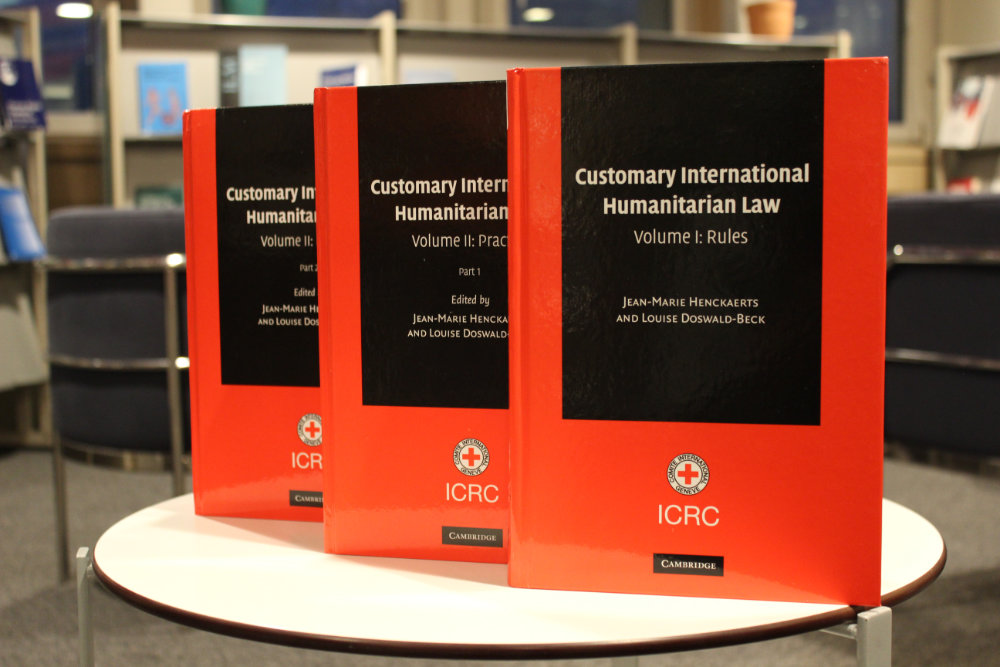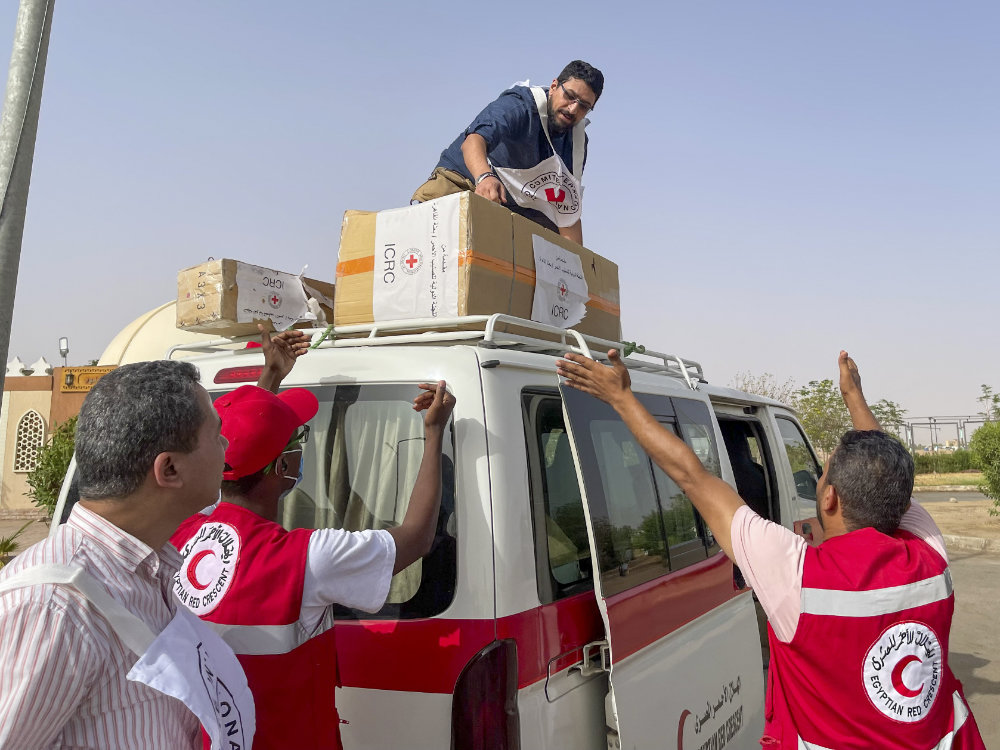In today’s multilateral disarmament, peace and security, and humanitarian fora, a key responsibility of states – and a challenge for their lawyers and policy makers – is to find common understandings on the international legal limits on information and communication technology (ICT) activities during armed conflicts. Following over two decades of discussions – and gradual progress – in UN General Assembly mandated groups of governmental experts and open-ended working groups on the use of ICTs, multilateral efforts to agree to such limits have reached an important juncture.
In this post, the ICRC’s Laurent Gisel and Tilman Rodenhäuser highlight the significant progress achieved on the protection of civilian populations against ICT activities through the adoption of ‘the first humanitarian ICT resolution’ at the 34th International Conference of the Red Cross and Red Crescent Movement in October 2024. The authors discuss the trajectory that this resolution sets for multilateral work in the UN Open-Ended Working Group that concludes this year, for the ICTs workstream of the Global Initiative on IHL, and the ICRC’s project on a digital emblem.
Step one: building common understandings on the potential human cost of ICT activities
Today, all states recognize that a ‘number of States are developing ICT capabilities for military purposes’, that ICTs ‘have already been used in conflicts in different regions’, and ‘that the use of ICTs in future conflicts between States is becoming more likely’. No expert or government questions that ICT activities by state and non-state actors pose a threat to civilian populations. Threats include cyber operations that disrupt essential services such as electricity, water, healthcare, communication, or humanitarian operations, and digital information operations that pose direct and indirect harm to individuals.
Many of these threats exist at all times; however, their potential human cost is higher in times of armed conflict. During armed conflict, belligerents put significant resources into harming the enemy, and the damage and disruption caused by ICT activities comes on top of the devastation caused by other means and methods of warfare.
In October 2024, all states and National Red Cross and Red Crescent Societies convened in Geneva for the 34th International Conference of the Red Cross and Red Crescent Movement. In this unique humanitarian forum, participants adopted a groundbreaking resolution on “Protecting civilians and other protected persons and objects against the potential human cost of ICT activities during armed conflict.” The resolution underlines the importance of ICTs in the ‘delivery of a variety of goods and services, including medical services for the civilian population, for humanitarian operations, for civilians to seek and receive information in an accessible format about where to find safety and objects essential for their survival, and for maintaining or restoring family links, including in situations of armed conflict’.
States and the Red Cross and Red Crescent Movement expressed concern about cyber operations causing harm across international borders, affecting ‘goods indispensable to the survival of the civilian population, works and installations containing dangerous forces, or civilian critical infrastructure’. In addition, they agreed that the use of ICTs to spread information to ‘cause, instigate, or amplify harm to the civilian population or other protected persons and objects during armed conflict’ is a concern. And just as the UN Security Council earlier in the same year, the Red Cross and Red Crescent Conference expressed deep concern about the ICT activities affecting humanitarian organizations.
There is no doubt that a common understanding exists on the potential human cost of ICT activities during armed conflict. More importantly, there is also political will to prevent this cost: In the ICT resolution, all states also committed to ‘protect the civilian population and other protected persons and objects in situations of armed conflict, including against the risks arising from malicious ICT activities’ (OP1). But what does this mean concretely?
Step two: recognizing and affirming the applicable international legal limits
In the UN, since 2013 states have concluded that ‘international law […] is applicable and essential to maintaining peace, security and stability and promoting an open, secure, stable, accessible and peaceful ICT environment’. All states agree that they must respect the UN Charter, in particular the prohibition against the threat or use of force, and settle disputes peacefully. To offer ‘an additional layer of understanding […] of how international law applies to the use of ICTs by States’, in 2021 governmental experts, endorsed by the General Assembly, ‘noted that international humanitarian law applies only in situations of armed conflict’, ‘recognised the need for further study on how and when [established international legal] principles apply to the use of ICTs by States’, including, ‘where applicable, the principles of humanity, necessity, proportionality and distinction’, while also underscoring that ‘recalling these principles by no means legitimizes or encourages conflict’.
To build on this agreement, and advance common understandings on how international humanitarian law applies to the use of ICTs in armed conflict, in 2024 the ICRC tabled ‘the first humanitarian ICT resolution’ at the 34th International Red Cross and Red Crescent Conference, which was adopted without a vote by states and the Red Cross and Red Crescent Movement.
While the resolution recognizes that ‘States have expressed a diversity of views’ on ‘how principles and rules of IHL apply to ICT activities in situations of armed conflict’, the resolution highlights agreement on the protective value of some of the most fundamental IHL rules and principles. Concretely, the ICT resolution, among many other things,
- “reiterates that, in situations of armed conflict, IHL rules and principles […] serve to protect civilian populations and other protected persons and objects, including against the risks arising from ICT activities”. (OP4)
- “calls on parties to armed conflicts to respect and protect medical personnel, units and transports […], including with regard to ICT activities”. (OP6)
- “calls on States and parties to armed conflicts to allow and facilitate impartial humanitarian activities during armed conflict, including those that rely on ICTs, and to respect and protect humanitarian personnel and objects […], including with regard to ICT activities”. (OP7)
- “calls on parties to armed conflicts to protect […] civilian critical infrastructure that provides services across several States, including the technical infrastructure essential to the general availability or integrity of the internet, [such as] undersea cables and orbit communication networks”. (OP5)
The resolution, however, does not stop at recalling the basics. It recognizes current realities in which ‘ICTs may enable or be used to encourage civilians to conduct or support ICT activities in armed conflict’, and where ‘private technology companies provide a range of ICT products, services and infrastructure on which civilian populations, governments and humanitarian organizations rely’. Against this background, it also calls for dedicated efforts by states and the Red Cross and Red Crescent Movement to make IHL known to the entire population, for states to enforce these rules, and for the Movement to also engage with technology companies on IHL (OPs 9 and 11).
Step three: building on the acquis, and strengthening the protection of civilian populations
Diplomats and other participants at the 2024 Red Cross and Red Crescent Conference have called the ICT resolution ‘a really significant step forward’ and ‘groundbreaking’. To address the threats identified in the resolution, and to operationalize the commitments made, the ICRC is engaging state and non-state parties to armed conflict as well as tech companies on a range of issues. In addition, we hope the resolution can be a steppingstone towards deepening the common understandings on the protection of civilian populations against ICT activities during armed conflict.
A first indicator of whether states are committed to advance further will be the adoption by consensus of a final report in the UN Open-Ended Working Group on ICTs, which concludes its work in July 2025. Building on five years of discussions and several progress reports, the final report will likely express concern about the use of ICTs in armed conflicts and their human and societal costs. If the threats are clear, states have a collective responsibility to also reaffirm that in situations of armed conflict, IHL rules and principles serve to protect civilian populations and other protected persons and objects, including against the risks arising from ICT activities. Language to facilitate consensus may be drawn from the above-presented ICT resolution, which has been referred to positively by many states in the December 2024 session of the working group.
To support the negotiations, over the past years the ICRC has provided states with short papers on how IHL applies to the use of ICTs during armed conflict, in particular the principles of humanity, necessity, distinction and proportionality. Today, the ICRC has also added two short papers on the protection of medical facilities and of humanitarian operations against ICT activities.
Remaining at the smallest common denominator, however, is not sufficient. In September 2024, six states – Brazil, China, France, Jordan, Kazakhstan and South Africa – together with the ICRC, have launched a global initiative to galvanize political commitment to IHL. This initiative includes a workstream aimed at fostering common understandings among states on how IHL imposes limits on ICT activities during armed conflicts to safeguard civilian populations from harm. This workstream provides a possibility to build additional common ground between states on ‘how’ existing rules of IHL protect civilian populations. The specificities of the ICT environments – such as the often-non-physical nature of damage caused, the need to protect data against damage and destruction in our data-driven world, and the widespread civilian involvement in ICT activities – require further attention. While the ICRC already submitted its positions on some of these issues, and so have states, the ICTs workstream will provide a humanitarian forum dedicated to developing common understandings.
In addition, as warfare digitalizes, IHL-based tools to protect civilian populations against harm must also digitalize. Since 2022, the ICRC has studied legal, technological, and diplomatic questions regarding the development of a ‘digital emblem’, meaning a digital signal designed to identify in the ICT environment the digital assets of the medical services and certain humanitarian operations that are entitled to use the distinctive emblems recognized under IHL. In the 2024 ICT resolution, states and the Red Cross and Red Crescent Movement encouraged ‘the ICRC to continue consulting and actively engaging with States and Movement components to further assess and clarify the specific purpose and technical feasibility of a digital emblem’ and ‘to study possible legal and diplomatic avenues in this respect’ (OP12). Combined with a pledge by nearly 160 significant tech companies of the ‘Cybersecurity Tech Accord’ to ‘champion the digital emblem’, and to collaborate to advance it – which was issued just weeks after the resolution – a real possibility has emerged to advance the development of a digital emblem to pass a century old message: Do not target medical services or humanitarian operations.
Conclusion
The ‘first humanitarian ICT resolution’, adopted in October 2024, provides a steppingstone for further progress for the protection against civilian populations from ICT activities during armed conflict. Even in times of heightened tensions, and especially in light of the unprecedentedly high number of armed conflicts in the world, common ground on how to uphold the protection of civilian populations in the face of the rapid digitalization of warfare must be found. The coming months and years provide an opportunity for states to demonstrate their commitment to continue on the path they have started to build.
See also:
- Samit D’Cunha, Tristan Ferraro & Tilman Rodenhäuser, ‘Hybrid threats’, ‘grey zones’, ‘competition’, and ‘proxies’: When is it actually war?, January 16, 2025
- Cordula Droege, Championing IHL compliance in contemporary armed conflict: the 2024 ICRC Challenges Report, October 9, 2024
- Kubo Mačák & Tilman Rodenhäuser, Towards common understandings: the application of established IHL principles to cyber operations, March 7, 2023
- Tilman Rodenhäuser & Mauro Vignati, Towards a ‘digital emblem’? Five questions on law, tech, and policy, November 3, 2022






